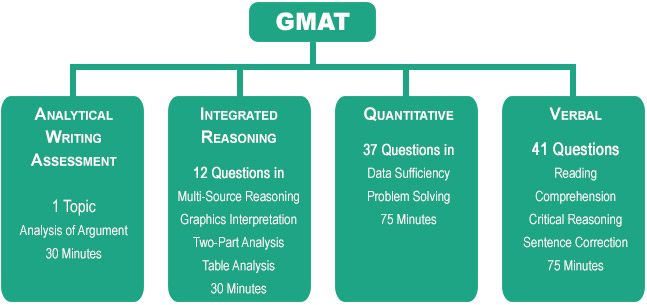GMAT
What is GMAT?
The Graduate Management Admission Test (GMAT) is a computer adaptive test (CAT) intended to assess certain analytical, writing, quantitative, verbal, and reading skills in written English for use in admission to a graduate management program, such as an MBA. It requires knowledge of certain grammar and knowledge of certain algebra, geometry, and arithmetic. According to the test-owning company, the Graduate Management Admission Council (GMAC), the GMAT assesses analytical writing and problem-solving abilities, while also addressing data sufficiency, logic, and critical reasoning skills that it believes to be vital to real-world business and management success.
Who is eligible for GMAT?
Since GMAT is used for entrance into graduate programs, only holders of a degree or undergraduate students about to graduate
How many take GMAT?
GMAT has over 250,000 intakes per year and gives you the opportunity to take the exam 5 times a year, 16 days apart.
What does GMAT entail?
The GMAT exam consists of four sections: an analytical writing assessment, an integrated reasoning section, a quantitative section, and a verbal section.
[list type=”check”]
- An analytical writing assessment
- An integrated reasoning section
- A quantitative section
- A verbal section.
[/list]
Analytical Writing Assessment (AWA)
The AWA consists of one 30-minute writing task—analysis of an argument. It is important to be able to analyze the reasoning behind a given argument and write a critique of that argument. The essay will be given two independent ratings and these ratings are averaged together to determine the test taker’s AWA score.
Integrated Reasoning
Integrated Reasoning (IR) is a section introduced in June 2012 and is designed to measure a test taker’s ability to evaluate data presented in multiple formats from multiple sources. The skills being tested by the integrated reasoning section were identified in a survey of 74
Quantitative Section
The quantitative section of the GMAT seeks to measure the ability to reason quantitatively, solve quantitative problems, interpret graphic data, and analyze and use information given in a problem. Questions require knowledge of certain algebra, geometry, and arithmetic.
Verbal section
The verbal section of the GMAT exam includes the following question types: reading comprehension, critical reasoning, and sentence correction. Each question type gives five answer options from which to select.
Advantages of taking GMAT
Career Opportunity
GMAT is meant for graduate admission schools but some employers use it too. So achieving a good score in GMAT leads you to the bright career opportunities in this competitive world.
Validity
The test scores for GMAT is valid for 5 years meaning you can use it 5 years from when you take the exam, this is a plus compare to other exams
Age limit
There is no age limit for GMAT
Consistent—Over Time and Across the Globe
No matter where or when the GMAT exam is administered, it tests the same skills with the same level of accuracy. Even when candidates retake the test, their scores normally do not vary significantly.
Precision
The GMAT exam is computer adaptive, which means it selects each question for the test taker based on his or her ability level. This makes the GMAT Total score an extremely precise measure of an individual’s ability.
Security
Advanced identification procedures and standardized test administration conditions set the stage for the high level of security the GMAT exam is known for.
Why take GMAT training at the Indian Institute of Foreign Languages?
Taking the GMAT exam shows schools that you’re serious about graduate business education. For students in India, this is the best place for you to take the training given our modern infrastructure and experts on ground.
We hope to hear from you soon!
[divider scroll_text=”go back up”]

